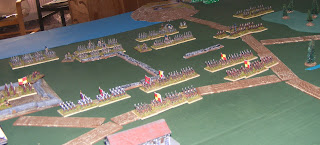General Jacques du Villefort, Count of Suignac landed on Suillen with a large force. He had six battalions of foot, four cavalry regiments and two regimental guns in support of his first line. The frigate 'La Vengeance' provided support with its heavy guns.
Glambrian deployment with Fort Suillen in view: the fort is defended by a pair of large cannon, a regular Grenadier and a militia battalion.
The Formaggian army under the elder duke of Calvacasa disembarked in the north and arrived with a forced march. The chances were even, although a storm erupted and prevented the Duke to land his artillery on the island. He had to rely on the fort's guns.
The Formaggian foot was of the better kind, serving as mercenaries for several courts (including the Glambrian, by the way), so they deployed quickly.
La Vengeance opened fire on the fort to breach the walls while the Glambrian infantry, landsick after the fresh landing, moved forward to meet the Formaggian main force.
The Glambrian regular horse outflanked the Fromaggian first line and trod down the rightmost battalion. The one next to it managed to wheel just in time.
The Formaggian cavalry had difficulties deploying from columns and their charge was broken up by the creek, but their advantage in numbers decided the clash between the two groups of cavalry.
While the Glambrian right, engulfed in smoke, attempted to assault the fort, their other flank was threatened by the larger Formaggian cavalry force.
The walls were breached and the Formaggian units standing right below the fort were not able to maneuver back to the road and aid those inside. The attackers captured one of the heavy guns and a bloody melee ensued between them and the Formaggian grenadiers.
The Formaggians repulsed the attack and the Glambrian battalion fled the scene; both units manning the fort were torn to pieces by the frigate's close range fire. The assaulting Glambrians spiked every cannon in the fort so the Vengeance could move closer.
The main Formaggian line, supported by their victorious cavalry, striked down on the remaining Glambrian units: the exhausted enemy ran, leaving behind only an artillery battery. The Formaggian morale was also fading, and when the Comte de Suignac rushed in and planted the Glambrian banner atop the fort's walls, the Formaggian force wavered and began to fall back: had their charge continued, there is no doubt the remaining Glambrians would have drowned in the sea with no way to retreat.
The Glambrian morale, with two units on the table out of a dozen, was 1/13 when the Commander-in-Chief climbed the walls of the objective. As such confusion generally happens during a battle, and with the Formaggian morale being just 3/13, I decided that the arms of Glambria won the day. This means the island is back in its old owner's hands, and Formaggian internal politics will become even messier, as the Chancellorette Schiavona's opponents are too happy to take advantage of the row of defeats culminating in the loss of the island.
Notes on the game: the forces were balanced in one way: both had a morale of 13 and an approximately similar main force. The Glambrians had more artillery and the Formaggians more foot. There was no winning moment and we were at the end of the third deck when the Glambrians broke under the weight of the cavalry assaulting their flank. Due to a chain of successful army morale rolls I allowed the Glambrian player to commit a ruse de guerre: the C-in-C could otherwise not occupy the objective, but with all the smoke and the sounds of battle, the Formaggians had no way to tell the state of the fight inside the walls. One of the hardest battles we have fought to date, that is certain.












No comments:
Post a Comment